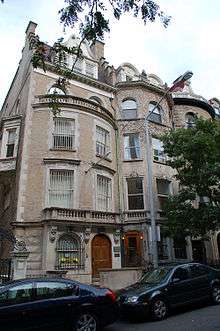Agni Yoga
| Agni Yoga | |
|---|---|
| Founders | Helena Roerich and Nicholas Roerich |
| Practice emphases | |
| Conscious striving in one's daily life | |
| Related schools | |
| Theosophy (Blavatskian) | |

Agni Yoga (Russian: Агни Йога) or the Living Ethics (Russian: Жива́я Этика), or the Teaching of Life (Russian: Учение Жизни) is a one of the neo-theosophical religious doctrine transmitted by the Helena and Nicholas Roerichs from 1920. The followers of Agni Yoga believe that the teaching was given to the Roerich family and their associates by Master Morya, the guru of Roerichs and Helena Blavatsky, one of the founders of the modern theosophical movement and the Theosophical Society.
Agni Yoga is a path of practice in daily life. It is the yoga of fiery energy, of consciousness, of responsible, directed thought. It teaches that the evolution of the planetary consciousness is a pressing necessity and that, through individual striving, it is an attainable aspiration for mankind. According to Helena Roerich, Agni Yoga is the synthesis of all yogas. In all the ancient Hindu scriptures, the approaching Fiery Age was predicted. Agni-Fire, which to a varying degree is at the heart of all the yogas, will extremely sate the atmosphere of our planet, and all the branches of Yoga will be merged into a fiery synthesis. Agni Yoga is a fire baptism.
The most significant features of Agni Yoga are cosmism and universalism. They are expressed in the interpretation of any phenomena of human existence from the point of view of their cosmic significance and interrelation with the being of the Universe.
Agni Yoga played a significant role in bringing knowledge of Asian religions to Western world. Living Ethics has an international following and has thousands of adherents. The ideas of Teaching of Life have exerted an influence on another esoteric movements and philosophies, among them the New Age and Transhumanism.
Birth of the new religion
.jpg)
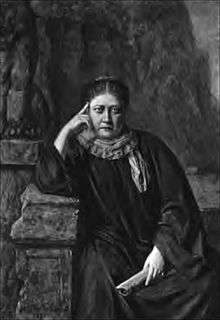
Etymology and concept
Agni (Sanskrit: अग्नि) is the Vedic and Living Ethics God of Fire, one marks immortality and the symbol of life. Agni is one of the supreme gods in the Rigveda. In Agni Yoga it is the Creative Fire of the Universe, the root of the "Fire of Space"; and "psychic energy", the powers of the human mind and heart, particularly those manifesting in love, thought, and creativity.[1]
Yoga (Sanskrit: योग; ![]()
Aum or Oṃ (Devanagari: ॐ), ![]()
Ur or Aditi (Sanskrit: अदिति "limitless"),[8] in the Vedas and Living Ethics is the Mother of the gods and all twelve zodiacal spirits from whose cosmic matrix the heavenly bodies were born. As celestial mother of every existing form and being, the synthesis of all things, she is associated with space and with mystic speech. She is mentioned nearly 80 times in the Rigveda: the verse "Daksha sprang from Aditi and Aditi from Daksha" is seen by Theosophists as a reference to "the eternal cyclic re-birth of the same divine Essence" and divine wisdom.[9] "Ur is the root of the Light of Fire", it is stated in the holy writ of Agni Yoga.[10]
Shambhala (Sanskrit: शम्भलः, Tibetan: བདེ་འབྱུང ;) is a birthplace of Kalki, the final incarnation of Vishnu, who will usher in a New Age — Satya Yuga. Shambhala is ruled over by Maitreya.[11] The Kalacakra Tantra prophesies that when all is lost, Kalki will emerge from Shambhala to vanquish "Dark Forces" and usher in a worldwide Golden Age. Shambhala is also called Shangri-la.[12]
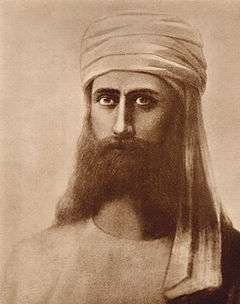
Morya is one of the Masters of the Ancient Wisdom within modern Theosophical beliefs.[14] He is one of the Mahatmas who inspired the founding of the Theosophy and Agni Yoga. He has written and dictated the letters with the goal of elevating mankind and bringing in a New Age.[15]
Tara Urusvati (The Light of the Morning Star) is the spiritual name of Helena Roerich (1879 – 1955) in Agni Yoga and Rerikhism.[16] She was a teacher and healer as well as the inspired co-author of the Agni Yoga series, the first English books about Living Ethics and the Roerichs' relationship with their Guru.[17] Each of the 935 paragraphs of the book "Supermundane" begins with the word "Urusvati".[18] In the epilogue of the book "Agni Yoga" she was called the Mother of Agni Yoga.[19]
Fuyama is the spiritual name of Nicholas Roerich (1874 – 1947) in Agni Yoga and Rerikhism. He was an internationally acclaimed artist, conservationist, archeologist, humanitarian and peacemaker.[20] Nicolas Roerich called Urusvati “She Who Leads” in his creations.[21]
Spiritual evolution is the philosophical, theological, esoteric or spiritual idea that nature and human beings and human culture evolve: either extending from an established cosmological pattern (ascent), or in accordance with certain pre-established potentials. The phrase "spiritual evolution" can occur in the context of higher evolution, a term used to differentiate psychological, mental, or spiritual evolution from the lower evolution or biological evolution of physical form.[22] The concept of spiritual evolution is also complemented by the idea of a creative impulse in human beings, known as epigenesis.[23]
Agni Yoga, in general, is a neo-theosophical religious doctrine[24] transmitted by the Helena and Nicholas Roerichs from 1920. The followers of Living Ethics believe that the teaching was given to the Roerichs' family[25] and their associates by Master Morya, the guru of Roerichs and Helena Blavatsky, one of the founders of the modern theosophical movement and the Theosophical Society.[26] Teaching of Life is a path of practice in daily life. It is the yoga of fiery energy, of consciousness, of responsible, directed thought. It teaches that the evolution of the planetary consciousness is a pressing necessity and that, through individual striving, it is an attainable aspiration for mankind.[27] The most significant features of Agni Yoga are cosmism and universalism. They are expressed in the interpretation of any phenomena of human existence from the point of view of their cosmic significance and interrelation with the being of the Universe.[28]
Precursors of Agni Yoga
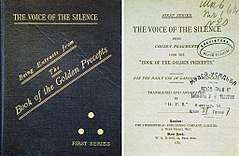
Theosophy
The Theosophical Society was officially formed in New York City on 17 November 1875 by Helena Blavatsky, Henry Steel Olcott, William Quan Judge, and others. It was self-described as "an unsectarian body of seekers after Truth, who endeavour to promote Brotherhood and strive to serve humanity." After a few years Olcott and Blavatsky moved to India and established the International Headquarters at Adyar, in Madras.[29]
Madame Blavatsky, the greatest occultist in the history of Western civilization, insisted that Theosophy is not a religion, although did refer to it as the modern transmission of the "once universal religion" that she claimed had existed deep into the human past. Theosophical organisations, regard it as a system that embraces what they see as the "essential truth" underlying religion, philosophy, and science. Theosophical groups allow their members to hold other religious allegiances, resulting in Theosophists who also identify as Christians, Buddhists, or Hindus.[30]
The term Neo-Theosophy was coined by Ferdinand T. Brooks around 1912. This term used by the followers of Helena Blavatsky to denominate the system of theosophical ideas expounded following the death of Blavatsky in 1891. This material differed in major respects from Blavatsky's original presentation, but it is accepted as genuinely theosophical by many theosophists around the world.[31] Daryl S. Paulson associates "Neo-Theosophy" with Alice Bailey.[32] She introduced the term New Age – Age of Aquarius.[33]
Other neo-theosophists include Rudolf Steiner's contemporary Peter Deunov and Samael Aun Weor. Dion Fortune and Aleister Crowley were also influencers of the leading edge of the theosophical movement. Some examples of neo-theosophists today include Benjamin Creme and Victor Skumin. So, in 1990, Skumin, based on the theosophical concept of spiritual evolution, proposed a classification of Homo spiritalis (Latin: Spiritual man), the sixth root race, consisting of eight sub-races (subspecies): HS-0 Anabiosis spiritalis, HS-1 Scientella spiritalis, HS-2 Aurora spiritalis, HS-3 Ascensus spiritalis, HS-4 Vocatus spiritalis, HS-5 Illuminatio spiritalis, НS-6 Creatio spiritalis, and HS-7 Servitus spiritalis.[34]
Russian philosophy and Russian Cosmism
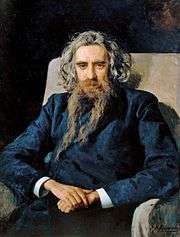
Russian philosophy as a separate entity started its development in the 19th century, defined initially by the opposition of Westernizers, advocating Russia's following the Western political and economical models, and Slavophiles, insisting on developing Russia as a unique civilization. The latter group included Nikolai Danilevsky and Konstantin Leontiev, the early founders of eurasianism. Slavophilia was an intellectual movement originating from 19th century that wanted the Russian Empire to be developed upon values and institutions derived from its early history. There were also similar movements in Bulgaria, Croatia, Czechoslovakia, Poland, and Serbia. Depending on the historical context, its opposite could be termed Slavophobia, a fear of Slavic culture.[35]
The discussion of Russia's place in the world has since become the most characteristic feature of Russian philosophy. Notable philosophers of the late 19th and early 20th centuries include Vladimir Solovyev, Vasily Rozanov, Lev Shestov, Leo Tolstoy, Sergei Bulgakov, Pavel Florensky, Pitirim Sorokin.In its further development, Russian philosophy was also marked by deep connection to literature and interest in creativity, society, religion, and Russian cosmism.[36]
Vladimir Solovyov described his encounters with the entity Sophia in his works, such as Three Encounters and Lectures on Godmanhood. His fusion was driven by the desire to reconcile or unite with Orthodox Christianity the various traditions by the Russian Slavophiles' concept of sobornost. His Russian religious philosophy had a very strong impact on the Russian Symbolist art movements of his time. His teachings on Sophia, conceived as the merciful unifying feminine wisdom of God comparable to the Hebrew Shekinah or various goddess traditions, have been deemed a heresy by Russian Orthodox Church Outside Russia and as unsound and unorthodox by the Patriarchate of Moscow.[37]
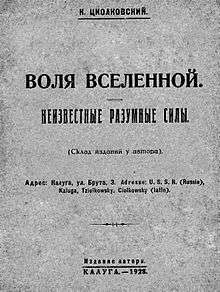
Nikolai Fyodorov was a Russian Orthodox Christian philosopher, who was part of the Russian cosmism movement and a precursor of transhumanism. Fedorov argued that humanity is the culmination of evolution, as well as its creator and director. Humans must therefore direct evolution where their reason and morality dictate. Fedorov stated that the struggle against death can become the most natural cause uniting all people, regardless of their nationality, race, citizenship or wealth. He called this the Common Cause. Fedorov thought that death and afterdeath existence should become the subject of comprehensive scientific inquiry, that achieving immortality and revival is the greatest goal of science.[38]
At the beginning of the 20th century, there was a burst of scientific investigation into interplanetary travel, largely driven by the fiction writers such as Jules Verne and Herbert Wells as well as philosophical movements like Russian cosmism. In 1903, Konstantin Tsiolkovsky published the first serious scientific work on space travel. His work was essentially unknown outside the Russia, but inside the country it inspired further research, experimentation and the formation of the Society for Studies of Interplanetary Travel.[39]
The ideas of the Russian philosophers and cosmists later were developed by those in the transhumanist movement and Rerikhism.[40][41] For example, the Russian scientist Victor Skumin argues that the Culture of Health will play an important role in the creation of a human spiritual society into the Solar System.[42]
Historical development
Information about Vedanta and Buddhism spread in Western countries in the first decade of the 20th century. In the United States of the 1920s, when the voises in religion were arguing over fundamentalism and modernism as the only available choice, and long before Shangri-La had become a popularly accepted myth, a vanguard movement was promoting the alternative of the wisdom of the Eastern world.[43]
The Agni Yoga Society
.jpg)
The Agni Yoga Society was founded in 1920 by Helena and Nicholas Roerich. It is a non-profit educational institution incorporated in 1946 under the laws of the State of New York, and is supported entirely by voluntary contributions and membership dues. The organization was located in the building Master Apartments. The aims of the Society are embodied in the philosophy that gives it its name—Agni Yoga—as contained in the books of the Agni Yoga Series published by the Society. In them is found a synthesis of ancient Eastern beliefs and modern Western thought and a bridge between the spiritual and the scientific. Unlike previous yogas, Agni Yoga is a path of practice in daily life. It is the yoga of fiery energy, of consciousness, of responsible, directed thought. It teaches that the evolution of the planetary consciousness is a pressing necessity and that, through individual striving, it is an attainable aspiration for mankind. Though not systematized in an ordinary sense, it is a teaching that helps the student to discover moral and spiritual guide-posts by which to learn to govern his or her life and thus contribute to the common good. For this reason Agni Yoga has been called a Living ethic. Speaking about the role of personality in the spiritual evolution of mankind, Helena Roerich wrote,[27]
The greatest benefit that we can contribute consists in the broadening of consciousness, and the improvement and enrichment of our thinking, which, together with the purification of the heart, strengthens our emanations. And thus, raising our vibrations, we restore the health of all that surrounds us.
Master Institute of United Arts
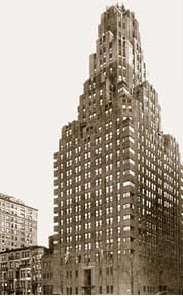
Nicolas Roerich is known as a thinker and a builder of life. His art and writings are an evocation to Beauty, to Knowledge, and to Culture. His vision is nicely captured in his philosophical statement of the Master Institute of United Arts which he formed in New York City in 1921:[44]
Art will unify all humanity. Art is one – indivisible. Art has its many branches, yet all are one. Art is the manifestation of the coming synthesis. Art is for all.
Mr. and Mrs. Horch financed and directed the Master Institute that taught the fine and dramatic arts. For much of its existence, the Master Institute was housed in the Master Apartments, designed by Harvery Wiley Corbett in 1929 for Roerich and built on the site of the former Horch mansion at 310 Riverside Dr. in New York City.[45]
Roerich planned to realize the educational concepts at the Institute. He invited as teachers such famous people as George Bellows, Claude Fayette Bragdon, Norman Bel Geddes, Stark Young, Deems Taylor, Robert Edmond Jones, and Lee Simonson.[46]
Himalayan Research Institute named Urusvati
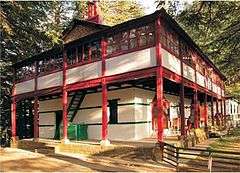
Roerich's family moved to India in December 1923. They settled in Darjeeling, a town in the Indian state of West Bengal. It is located in the Lower Himalayan Ranges at an elevation of 6,700 ft (2,042.2 m).[47]
The plethora of materials collected during the Central Asia Expedition became the foundation for the establishment of the Himalayan Research Institute named 'Urusvati' in Darjeeling in 1928. A few months later the institute moved to Naggar in Kulu Valley. The center engaged in scientific exchange with 285 institutes, universities, museums, and libraries around the world. George de Roerich was a world-renowned scientist, orientalist, and guru.[48] His monumental translation of the Blue Annals (Tibetan: དེབ་ཐེར་སྔོན་པོ )[49] , and his 11-volume Tibetan-Russian-English dictionary with Sanskrit parallels were published in 1934.[50]
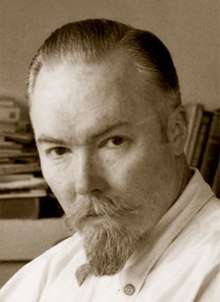
One of his main focuses for the center was to bring people to the Institute who practiced and lived the cultures being examined by the center. George Roerich was the director of the Himalayan Research Institute named Urusvati for 10 years.[51]
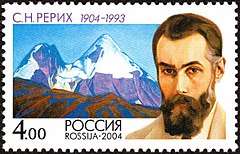
Svetoslav Roerich was in charge of the work of the Natural Sciences Department. He carried out unique researches in various fields of the natural sciences. At the basis of his scientific investigations was understanding of nature as one whole that is inalienably connected with the cosmic laws. The scope of his interests: cultural studies, comparative religious studies and philosophy, botany, mineralogy, tibetan pharmacopoeia, chemistry and its alchemical sources.[52]
The work of the Himalayan Research Institute was based on wide international cooperation.[53] Major scientists and cultural workers collaborated with the Institute Urusvati. Such as Soviet academician Nikolai Vavilov, biologist and biophysicist Jagadish Chandra Bose, Bengali polymath Rabindranath Tagore, the father of Indian journalism Ramananda Chatterjee, Indian philosopher and statesman Sarvepalli Radhakrishnan, Swedish geographer and explorer Sven Hedin, and many others.[54]
The Journal of the Urusvati Himalayan Research Institute (U.J.) published articles on various aspects of science and culture. The publications presented a multi-level perception of the authors who were looking for a new integration of different cultural models in the mainstream of Agni Yoga.[55]
Nicholas Roerich Museum
The Nicholas Roerich Museum in New York City was originally located in the Master Apartments at 103rd Street and Riverside Drive (Manhattan), which were built especially for Roerich in 1929. Now the museum is located in a brownstone at 319 West 107th Street on Manhattan's Upper West Side. Currently, the museum includes between 100 and 200 of Roerich's works as well as a collection of archival materials and still attracts pilgrims from throughout the world. The mission of the Nicholas Roerich Museum is one: to make available to the public the full range of Roerich’s accomplishments. They cover the realms of art, science, spirituality, peacemaking, and more.[56]
The Nicholas Roerich Museum in New York is the largest center of Roerich-related activity outside of Russia.[57]
International Center of the Roerichs
International Center of the Roerichs (Russian: Междунаро́дный це́нтр Ре́рихов) is a non-governmental public association of citizens and public associations incorporated on the basis of their common interests in the cause of study, preservation, and popularization of the Roerich family heritage. The Center is an associated member of the Non-Governmental Organizations Association under the United Nations Department of Public Information.[58]
Museum named after Nicholas Roerich (Russian: Музе́й и́мени Н. К. Ре́риха Междунаро́дного це́нтра Ре́рихов) contents comprises the Roerichs' cultural heritage passed on to the Soviet Roerichs' Foundation (now International Center of the Roerichs) by Svetoslav Roerich in 1990. It carries in itself a new cosmic world view for which new interest grows more each year. The core of the Rerikhism is the philosophy of cosmic reality – the Agni Yoga, which develops the idea of a close relationship between man and Cosmos, contains knowledge which assists in understanding the specific features peculiar to the new evolutionary stage of mankind's development.[59]
The World Organisation of Culture of Health
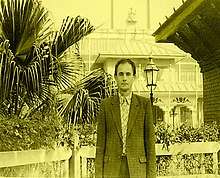

The World Organisation of Culture of Health (WOCH) — International social movement To Health via Culture (Russian: Междунаро́дное обще́ственное Движе́ние «К Здоро́вью че́рез Культу́ру») was founded in the year 1994. Victor Skumin was elected to the post of the President-founder of this organisation. The WOCH operates in accordance with the registered in Ministry of Justice of the Russian Federation Charter.[60]
WHCO, in order to promote international relations, has established a link with the International Buddhist Meditation Centre.[61]
In Agni Yoga much attention is paid to health. So in the book Supermundane (paragraph 525) recorded the words of Mahatma Moria, addressed to Urusvati,[62]
Urusvati knows that people are responsible for three aspects of health. First, their own health; second, the health of the planet; and finally, the health of the Supermundane World... People must safeguard their own health, not only for themselves but also for those around them. The human organism, though seemingly small, is a powerful repository of energy, and truly dominates its earthly environment.
It is from these positions that WOCH approaches the solution of problems related to health.
The anthem of WOCH (To Health via Culture) consists of four stanzas. The capital letters each of the four stanzas form the word Agni.[63][64] (Anthem "To Health via Culture." on YouTube). Another anthem by Skumin is termed "Urusvati". Helena Roerich, known as the Tara Urusvati in Agni Yoga and Rerikhism. This anthem begins with the phrase, "The fire of the heart ignites Urusvati, she teaches the spirit take-off on the wings of the grace".[64]
In the Russian Orthodox Church the social activities of this international organization qualifies as an ideology of the Agni Yoga and New Age (NA),[65][66]
The ideology of the NA serves outstanding contemporary philosophers: Gregory Bateson, Ken Wilber, Paul Feyerabend. On a grand scale is the creation and support of international organizations, contained in the ideology of the NA. In Russia and in Ukraine, International movement "To Health via Culture", based on the teachings of Agni Yoga, operates and has a great publishing activity.
The WOCH has its own publishing house ("To Health via Culture"), who has the right to publish the books with the International Standard Book Number (ISBN). The Journal of the World Organisation of Culture of Health (″World Health Culture Organization″) is based in Novocheboksarsk. The journal received an International Standard Serial Number (ISSN) 0204-3440.[67] The main topics of the magazine are the dissemination of ideas of culture of health, holistic medicine, Rerikhism, and Agni Yoga.[68]
The Holy Scripture of Agni Yoga
.jpg)
._%D0%9D%D1%8C%D1%8E-%D0%99%D0%BE%D1%80%D0%BA%2C_%D0%9F%D0%B0%D1%80%D0%B8%D0%B6%2C_%D0%A0%D0%B8%D0%B3%D0%B0%2C_%D0%A5%D0%B0%D1%80%D0%B1%D0%B8%D0%BD._%D0%90%D0%BB%D0%B0%D1%82%D0%B0%D1%81%2C_1925%C2%BB.jpg)
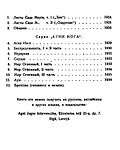
Agni Yoga is a Holy Scripture consisting of a series of books with a total volume of about 5000 pages.[71]
- "Leaves of Morya's Garden Book One The Call". agniyoga.org. 1924. Retrieved 11 September 2018. . Transmitted from 1920 to 1923. First published in Paris in 1923.
- "Leaves of Morya's Garden Book Two Illumination". agniyoga.org. 1925. Retrieved 11 September 2018. . Transmitted from May 1923 to June 1925.
- "New Era Community". agniyoga.org. 1926. Retrieved 12 September 2018.
- "Agni Yoga". agniyoga.org. 1929. Retrieved 12 September 2018.
- "Infinity Part I". agniyoga.org. 1930. Retrieved 12 September 2018.
- "Infinity Part II". agniyoga.org. 1930. Retrieved 12 September 2018.
- "Hierarchy". agniyoga.org. 1931. Retrieved 12 September 2018.
- "Heart". agniyoga.org. 1932. Retrieved 12 September 2018.
- "Fiery World I". agniyoga.org. 1933. Retrieved 12 September 2018.
- "Fiery World II". agniyoga.org. 1934. Retrieved 12 September 2018.
- "Fiery World III". agniyoga.org. 1935. Retrieved 12 September 2018.
- "Aum". agniyoga.org. 1936. Retrieved 12 September 2018.
- "Brotherhood". agniyoga.org. 1937. Retrieved 12 September 2018.
- "Supermundane". agniyoga.org. 1938. Retrieved 13 September 2018.
Further reading
- Roerich, Helena (1929–1935). "Letters of Helena Roerich I". agniyoga.org. Archived from the original on 17 March 2017. Retrieved 17 September 2018.
- Roerich, Helena (1935–1939). "Letters of Helena Roerich II". agniyoga.org. Retrieved 17 September 2018.
- Roerich, Helena. "Foundations of Buddhism". agniyoga.org. Retrieved 17 September 2018.
- Roerich, Helena (1992). "On Eastern Crossroads Legends and Prophecies of Asia". Agni Yoga Society, New York. Retrieved 23 September 2018.
- Roerich, Nicolas (2017). Realm of Light. New York: Nicholas Roerich Museum. Retrieved 22 September 2018.
- Roerich, Nicolas (2017). Shambhala. New York: Nicholas Roerich Museum. Retrieved 21 September 2018.
- Roerich, George (2012). По тропам Срединной Азии [On the paths of the Middle Asia] (in Russian). Moscow: International Center of the Roerichs. p. 780. Retrieved 24 September 2018.
- Roerich, Svetoslav (2004). Creative Thought / Articles by Svetoslav Roerich. Moscow: International Center of the Roerichs. p. 780. ISBN 5-86988-132-3. Retrieved 24 September 2018.
- Skumin, V. A. (1997). Учение Жизни: Хрестоматия Т. 1 [The Teaching of Life: Reader] (in Russian). 1. Novocheboksarsk: Teros. ISBN 5-88167-009-4. Retrieved 20 September 2018.
- Skumin, V. A. (1998). Учение Жизни: Хрестоматия Т. 2 [The Teaching of Life: Reader] (in Russian). 2. Novocheboksarsk: Teros. ISBN 5-88167-019-1. Retrieved 20 September 2018.
- Skumin, V. A. (1995). Легенды, притчи, сказания Агни Йоги [Legends, parables, and stories of Agni Yoga] (in Russian). Novocheboksarsk: Teros. ISBN 5-88167-008-6. Archived from the original on 7 January 2018. Retrieved 24 September 2018.
Gallery
Many works of Nicholas Roerich and Svetoslav Roerich, as an artists, are thematically related to Agni Yoga.[72] Roerichs artistic works speak about the internal needs of the individual and about the ways of their realization. Roerich's paintings are a kind of Teaching of Life, on the spiritual development of mankind, about culture and its role in human life. This is a conversation about the Eternal.[73]
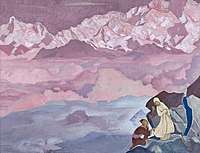 Nicholas Roerich. She who leads. 1943
Nicholas Roerich. She who leads. 1943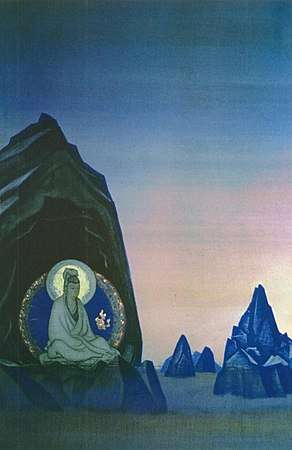 Nicholas Roerich. Agni Yoga. Diptych. Left part. 1928
Nicholas Roerich. Agni Yoga. Diptych. Left part. 1928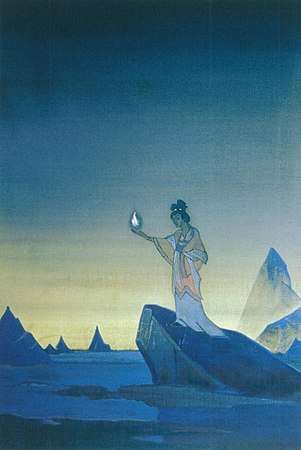 Nicholas Roerich. Agni Yoga. Diptych. Right part. 1928
Nicholas Roerich. Agni Yoga. Diptych. Right part. 1928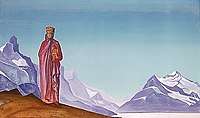 Nicholas Roerich. She who holds the World. 1933
Nicholas Roerich. She who holds the World. 1933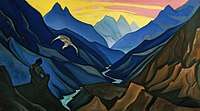 Nicholas Roerich. Precept of the Teacher. 1947
Nicholas Roerich. Precept of the Teacher. 1947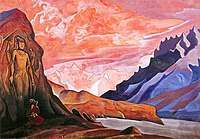 Nicholas Roerich. Maitreya the Conqueror. 1925
Nicholas Roerich. Maitreya the Conqueror. 1925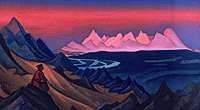 Nicholas Roerich. Song of Shambhala. 1943
Nicholas Roerich. Song of Shambhala. 1943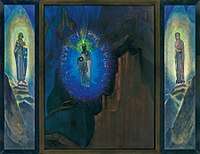 Nicholas Roerich. Fiat Rex. Triptych. 1931
Nicholas Roerich. Fiat Rex. Triptych. 1931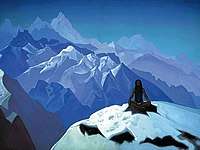 Nicholas Roerich. Tummo. 1936
Nicholas Roerich. Tummo. 1936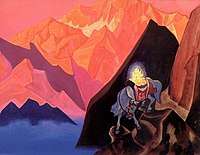 Nicholas Roerich. Chintamani - Lung ta. Between 1935 and 1936
Nicholas Roerich. Chintamani - Lung ta. Between 1935 and 1936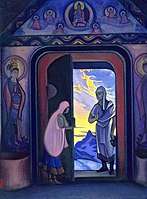 Nicholas Roerich. Messenger. 1946
Nicholas Roerich. Messenger. 1946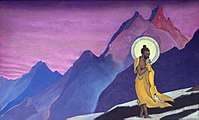
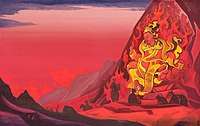 Nicholas Roerich.Command of Rigden Djapo. 1924
Nicholas Roerich.Command of Rigden Djapo. 1924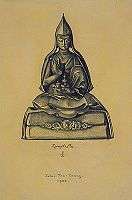 Nicholas Roerich. Je Tsongkhapa. 1924
Nicholas Roerich. Je Tsongkhapa. 1924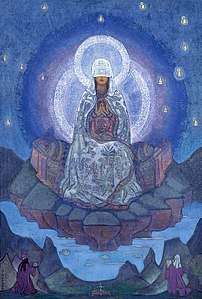 Nicholas Roerich. Mother of the World.[75] 1924
Nicholas Roerich. Mother of the World.[75] 1924
See also
References
- ↑ Bowker, John (1997). "World Religions". New York: DK Publishing, Inc. Archived from the original on 8 January 2018. Retrieved 10 September 2018.
- ↑ Georg Feuerstein (23 October 2012). The Yoga Tradition: Its History, Literature, Philosophy and Practice. Hohm Press. p. 37. ISBN 978-1-935387-39-8. Retrieved 10 September 2018.
- ↑ The Om Mala. Bloomsbury Publishing. ISBN 9789387471856. Retrieved 26 September 2018.
- ↑ Vālmīki (1891). The Yoga-vásishtha-mahárámáyana of Válmiki. 1. Bonnerjee and Company. p. 61. Retrieved 26 September 2018.
- ↑ James G Lochtefeld (2002). The Illustrated Encyclopedia of Hinduism. 2 N-Z. Rosen Publishing. p. 482. ISBN 978-0823931804. Retrieved 27 September 2018.
- ↑ "Aum". agniyoga.org. 1936. Retrieved 28 September 2018.
- ↑ Roerich, Helena (1929–1935). Letters of Helena Roerich. 1. agniyoga.org. p. 411. Retrieved 9 September 2018.
- ↑ From a- (privative a) and diti "bound," which is from the Proto Indo-European root *da- "to bind."
- ↑ "Adi-Ag: Encyclopedic Theosophical Glossary". Theosociety.org. Retrieved 4 October 2018.
- ↑ "Fiery World Part I Preface". agniyoga.org. Retrieved 7 October 2018.
- ↑ "Maitreya". Agni Yoga Society. 2006. Retrieved 23 September 2018.
- ↑ LePage, Victoria (1996). Shambhala: The Fascinating Truth Behind the Myth of Shangri-La. Quest Books. pp. 125–126. ISBN 9780835607506. Retrieved 18 September 2018.
- ↑ Sarah Diane Sasson (2012). Yearning for the New Age: Laura Holloway-Langford and Late Victorian Spirituality (Religion in North America). Indiana University Press. pp. 142–144. ISBN 9780253001771. Retrieved 27 September 2018.
«Hermann Schmiechen was a German painter living in London who had joined the Theosophical Society. He agreed to take part in a psychical experiment to see if images could be transferred to his mind from those who had seen the Masters...» - ↑ Skumin, V. A.; Aunovsky, O. K. (1995). Светоносцы (о семье Рерихов) [The Bringers of the Light (The story of the Roerich family)] (in Russian). Novocheboksarsk: TEROS. ISBN 5-88167-004-3. Archived from the original on 28 August 2017. Retrieved 10 September 2018.
- ↑ "El Morya on Prophecy, the New Era and the Age of Maitreya". Reverse Spins. Retrieved 24 September 2018.
- ↑ Skumin, V. A. (1995). Афоризмы Агни Йоги [Sutras of Agni Yoga] (in Russian). Novocheboksarsk: Teros. ISBN 5-88167-007-8. Archived from the original on 7 January 2018. Retrieved 12 September 2018.
- ↑ Drayer, Ruth Abrams (2014) [2005]. Nicholas & Helena Roerich: The Spiritual Journey of Two Great Artists & Peacemakers. Quest Books. p. 309. Retrieved 10 September 2018.
- ↑ "Supermundane". agniyoga.org. 1938. Retrieved 28 September 2018.
- ↑ "Agni yoga Epilogue". agniyoga.org. 1929. Retrieved 7 October 2018.
- ↑ Skumin VA (2004). "Фуяма — огненный Гуру-Покровитель духовного человечества" [Fuyama (N. Roerich's spiritual name) is a Fiery Guru-patron of spiritual humanity]. To Health via Culture. 10: 31–34. ISSN 0204-3440. Archived from the original on 17 December 2017. Retrieved 21 September 2018.
- ↑ "Helena Ivanovna Roerich (1879 – 1955)". irmtkullu.com. Retrieved 19 September 2018.
- ↑
Piyasīlo (1991). The Buddha's teachings: a study of comparative Buddhism in truth, tradition & transformation. Dharmafarer integrated syllabus series (2 ed.). Dharmafarer Enterprises. p. 130. ISBN 9789839030013. Retrieved 27 September 2018.
The instrument of this growth is the Dharma which is the path of the Higher Evolution. The term 'Higher' here refers to the mind - the basis of spiritual evolution. In contrast to the Higher Evolution, the biological (or Darwinian) evolution is known as the Lower Evolution.
- ↑
Heindel, Max (1922). The Rosicrucian Philosophy in Questions and Answers (3 ed.). Rosicrucian Fellowship. p. 10. Retrieved 27 September 2018.
Since the mind was given to man, it is this original creative impulse, epigenesis, which has been the cause of all our development[...]
- ↑ "Claiming Knowledge: Strategies of Epistemology from Theosophy to the New Age". books.google.ru. Retrieved 14 September 2018.
- ↑ "Roerichs' family". International Centre of the Roerichs. Retrieved 15 September 2018.
- ↑ "The Esoteric Studies Guide". katinkahesselink.net. Retrieved 10 September 2018.
- 1 2 "About Agni Yoga". agniyoga.org. Archived from the original on 19 February 2012. Retrieved 8 September 2018.
- ↑ Samokhina, N. E. (1994). Проблема человека в Агни-Йоге. Автореф. дисс. на соиск. уч. ст. канд. философ. наук [The problem of man in Agni Yoga. Thesis for the degree of candidate of philosophical sciences] (in Russian). Moscow State University. pp. 3–4. Retrieved 10 October 2018.
- ↑ The Theosophical Movement 1875–1950. Los Angeles: Cunningham Press. 1951. Retrieved 26 September 2018.
- ↑ Blavatsky, Helena (2013). Is Theosophy a Religion?. p. 24. ISBN 1258977710. Retrieved 10 September 2018.
- ↑ Theosophy Versus Neo-Theosophy: Margaret Thomas' Study of C. W. Leadbeater's and Annie Besant's Theosophical Teachings. Retrieved 26 September 2018.
- ↑ Paulson, Daryl S. (1999). "The Near-Death Experience: An Integration of Cultural, Spiritual, and Physical Perspectives". Journal of Near-Death Studies. New York, N.Y. : Human Sciences Press. 18 (1): 13–25. ISSN 0891-4494. OCLC 14781775. Retrieved 27 September 2018.
- ↑ Bailey, Alice A. (2012). Education in the New Age. gettextbooks.co.uk. p. 174. ISBN 978-0853301059. Retrieved 28 September 2018.
- ↑ Skumin, V. A. (1996). Человек духовный: роль культуры духовного здоровья в утверждении новой человеческой расы на планете [Spiritual man: The role of the Culture of spiritual health for approval of the new human race on the planet] (in Russian). theeuropeanlibrary.org. ISBN 5-88167-012-4. Archived from the original on 3 May 2016. Retrieved 27 September 2018.
- ↑ "Slavophile Russian history". Encyclopædia Britannica. Retrieved 10 October 2018.
- ↑ James T. Andrews (2009). Red cosmos: K.E. Tsiolkovskii, grandfather of Soviet rocketry (Centennial of Flight Series). Texas A & M University Press. p. 168. ISBN 9781603443609. OCLC 680622488. Retrieved 25 September 2018.
- ↑ "The Sophian heresy and attempts to feminize God". ecumenizm.tripod.com. Retrieved 30 September 2018.
- ↑ Nikolai Berdyaev. "The religion of resuscitative resurrection The "Philosophy of the Common Task" of N. F. Fedorov". berdyaev.com. Retrieved 11 October 2018.
- ↑ A. Bowdoin Van Riper (29 October 2007). Rockets and Missiles: The Life Story of a Technology. JHU Press. pp. 26–28. ISBN 978-0-8018-8792-5. Retrieved 13 October 2018.
- ↑ Art works by Russian cosmism painter XX – XXI ct. Catalogue of exhibition 2013. Roerich museum. 2013. Retrieved 19 October 2015.
- ↑ Skumin, V. A. (1995). Культура здоровья — фундаментальная наука о человеке [A Culture of Health as a fundamental human science] (in Russian). ISBN 5-88167-003-5. Retrieved 28 September 2018.
- ↑ Kovaleva E. A. (2009). "Педагогический совет. Культура здоровья учащихся как фактор здоровьесберегающей среды школы. Слайд 7" [Pedagogical Council. Slide 7 of the presentation "culture of health" to the lessons of physical education on the theme the "Health"]. 900igr.net. Retrieved 28 September 2018.
- ↑ Brian Taves (1985). "Philosophy Into Popular Fiction: Talbot Mundy and The Theosophical Society". Southern California QuarterlyTo. 67 (2): 153–186. doi:10.2307/41171147. Retrieved 14 September 2018.
- ↑ "Inspired By Art: Nicholas Roerich's Symbolic Journey". philosophicalsociety.org. Retrieved 21 September 2018.
- ↑ "Louis L. and Nettie S. Horch Papers, 1920s-1960s". columbia.edu. Retrieved 21 September 2018.
- ↑ "Nicholas Roerich Biography America". Nicholas Roerich Museum New York. Retrieved 16 September 2018.
- ↑ "Roerich Himalayan Museum Of Folk And Tribal Art". ignca.gov.in. Retrieved 14 September 2018.
- ↑ Skumin VA (2003). "Удрая – наш Духовный Наставник" [Udraia (George Roerich's spiritual name) is our Guru]. To Health via Culture. 9: 3–12. ISSN 0204-3440. Archived from the original on 17 December 2017. Retrieved 14 September 2018.
- ↑ "Summary of The Blue Annals Chapter 1: Early Indian history, Indian and Tibetan Imperial Lines, and the Early Spread of the Buddhist Teachings in Tibet". Tibetan and Himalayan Library. Retrieved 15 September 2018.
- ↑ "The Tibetan-Russian-English dictionary with Sanskrit parallels". The European Library. Archived from the original on 10 October 2016. Retrieved 14 September 2018.
- ↑ "George Roerich /Yuri Nikolayevich Roerich (1902 – 1960)". en.icr.su. Retrieved 14 September 2018.
- ↑ "Svetoslav Nikolayevich Roerich (1904-1993)". en.icr.su. Retrieved 15 September 2018.
- ↑ Aunovska, Olga (1985). "Seeds of fraternity". Ukraine. 4: 14–15. Retrieved 18 September 2018.
- ↑ "The Light of the Morning Star". International Centre of the Roerichs. Retrieved 17 September 2018.
- ↑ "Journal Of Urusvati Himalayan Research Institute, Volumes 1-3". books.google.ru. Retrieved 24 September 2018.
- ↑ Squires, Emily; Len Belzer (2000). Spiritual Places. Cosimo, Inc. p. 86. ISBN 1931044031. Retrieved 17 September 2018.
- ↑ "Nikolay Roerich". isfp.co.uk. Archived from the original on 19 March 2017. Retrieved 18 September 2017.
- ↑ "Extract from the Charter of the International public organization "International Center of the Roerichs"". en.icr.su. Archived from the original on 17 April 2017. Retrieved 17 September 2018.
- ↑ "The Nicholas Roerich Museum". en.icr.su. Archived from the original on 17 April 2017. Retrieved 17 September 2018.
- ↑ "Charter of the World Organisation of Culture of Health (Russian: Устав)". Kult-zdor.ru. Archived from the original on 18 April 2017. Retrieved 18 September 2018.
- ↑ "International Buddhist Meditation Centre". facebook.com. Retrieved 20 September 2018.
- ↑ "Supermundane, 525". Kult-zdor.ru. Retrieved 18 September 2018.
- ↑ Skumin, Victor (2002). Молитвы, гимны, притчи Культуры Здоровья [Culture of Health: prayers, hymns, parables] (in Russian). Cheboksary: To Health via Culture. ISBN 5-88167-018-3. Archived from the original on 17 December 2017. Retrieved 18 September 2018.
- 1 2 Skumin, Victor (2007). Гимны Культуры Здоровья [Gimns of Culture of Health] (in Russian). Cheboksary: To Health via Culture. ISBN 978-5-88167-030-6. Archived from the original on 17 December 2017. Retrieved 18 September 2018.
- ↑ Grantzev, V. I. "Критический анализ идеологии "Нью Эйдж" и оценка её общественной опасности" [A critical analysis of the ideology of the "New Age" and an assessment of its threat to society]. Orthodox-institute.ru. Archived from the original on 19 April 2017. Retrieved 18 September 2018.
- ↑ Grantzev, V. I. "Критический анализ идеологии "Нью Эйдж" и оценка ее общественной опасности. Текст" [A critical analysis of the ideology of the "New Age" and an assessment of its threat to society. Text]. www.scienceandapologetics.org. Archived from the original on 5 January 2018. Retrieved 18 September 2018.
- ↑ "K zdorovʹi︠u︡ cherez kulʹturu: zhurnal Mezhdunarodnogo obshchestvennogo dvizhenii︠a︡ "K zdorovʹi︠u︡ cherez kulʹturu"" [To health via culture: journal of the World Health Culture Organization]. catalog.loc.gov. OCLC 70966742. Archived from the original on 19 April 2017. Retrieved 19 April 2017.
- ↑ Ostrovidova L. A. (2016). "Skumin's sutras of Agni Yoga. Russian-English parallel texts. Leaves of Morya's garden. Book One: The Call". To Health via Culture. 25: 16–28. ISSN 0204-3440. Archived from the original on 17 December 2017. Retrieved 25 September 2018.
- ↑ "Община". agniyoga.org. 1926. Retrieved 16 September 2018.
- ↑ "Чаша Востока I Письма Махатмы" [Chasha Vostoka. I. Pisma Mahatmy]. ligatma.org. Archived from the original on 14 October 2018. Retrieved 14 October 2018.
- ↑ "What is Agni Yoga?". lebendige-ethik-schule.de. Archived from the original on 14 October 2018. Retrieved 14 October 2018.
- ↑ "Images". yahoo.com. Retrieved 16 September 2018.
- ↑ "The Museum Collection". Nicholas Roerich Museum NY. Archived from the original on 15 July 2016. Retrieved 29 September 2018.
- ↑ "A Treasury of Terms and Thoughts from the Agni Yoga Teachings: Ramakrishna". agniyoga.org. Retrieved 7 October 2018.
- ↑ "A Treasury of Terms and Thoughts from the Agni Yoga Teachings: Mother of the World". agniyoga.org. Retrieved 7 October 2018.
External links
- "Agni Yoga Society". agniyoga.org. Archived from the original on 17 March 2017. Retrieved 6 September 2018.
- "Agni Yoga Society Sweden". agniyoga.se. Archived from the original on 17 December 2017. Retrieved 4 September 2018.
- "International Roerich Memorial Trust". irmtkullu.com. Archived from the original on 11 October 2018. Retrieved 11 October 2018.
- "Nicholas Roerich Museum New York". roerich.org. Archived from the original on 15 July 2016. Retrieved 14 October 2018.
- "School for Living Ethics (Agni Yoga)". lebendige-ethik-schule.de. Archived from the original on 14 October 2018. Retrieved 14 October 2018.
Videos
- "Agni Yoga Web TV (English Channel)". youtube.com. Retrieved 4 September 2018.
- "Agni Yoga: Manu, Hierarchy, Shamballa". youtube.com. Retrieved 4 September 2018.
- "Lewis Keizer. Nicholas and Helena Roerich". youtube.com. Retrieved 4 September 2018.
- "Roerich. The Call Of Cosmic Evolution". youtube.com. Retrieved 11 September 2018.

